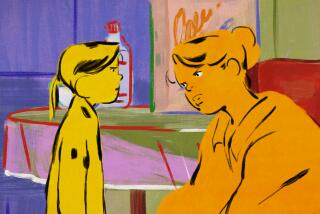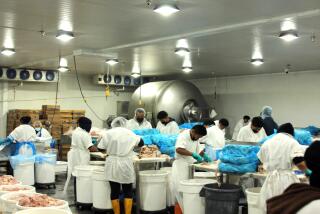In Fowl Territory
- Share via
Things the Colonel never told us about chickens:
Some wear red contact lenses. Ancient Romans thought the birds were psychic. The male possesses such a voracious sexual appetite that its nickname is slang--in several languages--for a human sex organ.
Also, and this is the alarming part, they might be taking over the world.
Long ignored by the Pentagon, the beaked creature has quietly scratched its way to the top of the food chain, installing a Tyson-bankrolled politician in the White House and overtaking beef in popularity.
Although some experts believe the McNuggetization of the planet is just a fad, others predict poultry’s conquest will be total, thanks to scientific experiments involving mutant superbirds and chicken that tastes like steak or shrimp.
“It’s going to rule the globe,” says Richard Lobb, human spokesman for the animal’s powerful lobbyist association, the National Broiler Council.
Among the frightening developments:
* Chickens now outnumber people 4 to 1.
* A National Poultry Museum just opened in Kansas, the heart of cattle country.
* The California Legislature recently invited a giant chicken mascot into its chambers and bestowed the bird with a commendation.
* Cow meat has hit new lows, with the once-mighty Big Mac slashed to a pathetic 55 cents, and much of bankrupt Hamburger Hamlet being swallowed up by Koo Koo Roo, an L.A.-based chicken chain.
* Newspapers report a disturbing pattern of chicken assaults against innocent humans. (Well, actually, we found only one article, but that’s probably because the birds have seized control of the media.)
*
Relations between chickens and Homo sapiens have always been uneasy.
From humble origins in the jungles of Southeast Asia, the pullet was initially domesticated thousands of years ago not for food, but for cockfighting.
The feathered Evander Holyfields were also recruited for fortunetelling. According to “Poultry Oddities” (Stromberg Publishing, 1992), Roman soothsayers drew an alphabet on the ground, dropped corn pellets on each letter and then noted which ones the rooster picked, sort of an ancient version of the Ouija board.
In Germany, gypsies predicted the sex of a baby by having the pregnant woman incubate an egg in her cleavage. The gender of the hatched chick was said to match the fetus.
From there, encounters with humans got progressively weirder. In an Ohio town, according to “Poultry Oddities,” hens strolling after sunset were required to wear tail lights. And at a Philadelphia ball, one couple showed up wearing live chickens as headgear.
In reaction, the wily beast has moved to consolidate its power. One of the boldest steps was electing poultry-industry puppet Bill Clinton, a longtime friend of Arkansas chicken tycoon Don Tyson.
Of course, Clinton isn’t the first president to fall under the bird’s spell. Andrew Jackson and Rutherford B. Hayes actually allowed fowl to live at the White House, according to poultry historian Loyl Stromberg of Minnesota. And Abraham Lincoln supposedly earned the nickname “Honest Abe” because of his reputation as a fair and impartial cockfight referee.
Still, something about the approaching millennium seems to have galvanized chicken pride. In 1990, the beady-eyed creature officially surpassed beef as America’s most popular meat (80 pounds per person a year, triple the 1960 consumption rate). And conspiracy theorists suggest that recent outbreaks of mad-cow disease in England and mad-pig disease in Taiwan are all part of a chicken coup d’etat.
*
None of this might matter if the chicken were a fuzzy, friendly little creature. But, in fact, it’s Mussolini with wings.
“If you put 100 birds in a pen,” says poultry expert Dick Creger, “they’ll soon establish a pecking order.” Literally.
The No. 1 hen can peck any of the other birds, but they can’t peck back. The No. 2 hen can peck any bird except No. 1, and so on until each fowl is ranked. Those at the bottom are in danger of losing their lives--unless the hens are seeing the world through rose-colored glasses.
In the 1950s, scientists discovered that red light soothes the savage chicken. Normally, when a beak battle draws blood, the sight of the gash causes other birds to gang up on the wounded party and peck it to death. In red light, the hens can’t see the blood, so they stay docile.
At first, farmers installed scarlet lightbulbs in chicken coops, but it was too dark for human workers. Next, someone invented red spectacles, but they kept falling off.
Now, Al T. Leighton, a former poultry sciences professor at Virginia Tech, has patented red contact lenses for chickens. So far, about 100,000 birds have tested the tiny plastic disks, Leighton says.
When the late syndicated columnist Mike Royko heard about it, he asked: “How do you teach chickens to put their contacts on and remove them? Won’t chicken coops be filled with chickens bending over and looking for dropped lenses?”
But Leighton says the devices are permanent--and harmless. Although animal rights activists contend the contacts can cause damage, Leighton insists chicken eyes are different from human ones.
Birds have a third eyelid, he says, which blinks behind the contact lens and keeps the eye healthy. UC Davis animal ophthalmologist Ned Buyukmihci disputes that safety claim, but the contacts are nevertheless expected to go on sale this year.
If the invention catches on, a worldwide chicken uprising seems inevitable. By ending internal combat, the birds would finally be free to turn their sociopathic behavior toward other species.
*
Chickens are also perverts.
According to Creger, who chairs Texas A & M University’s massive poultry sciences department, roosters can mate 20 to 30 times a day, a libido that puts even Warren Beatty to shame. “They will do it with anybody who stays still long enough--even a duck if it’s handy,” he says.
When chickens lived in the wild, sleeping in trees, this was probably necessary for survival. But with scientists now breeding indestructible superbirds--and the global chicken population at an unsettling 24 billion--the results could be disastrous.
For example, less than a century ago, it took 16 weeks for a newly hatched chick to grow to 2 pounds. Today, a pullet hits 4 pounds in a mere six weeks. And in Bonner Springs, Kan., the new National Poultry Museum is guarded by the statue of an 8-foot-tall rooster.
Artistic license, or a harbinger of things to come?
According to Stromberg’s encyclopedic “Poultry of the World” (Silvio Mattacchione & Co., 1996), a few birds have already crossed the 20-pound barrier. And a Cornell University professor recently discovered that 18th century classical music causes chickens to gain weight more efficiently.
Is it so hard, then, to imagine an army of 8-foot-high, red-contact-lens-wearing, Sony Walkman-playing roosters marching on New York City?
Even germ warfare might be useless against the feathered horde.
Normally, the birds are susceptible to scores of illnesses. Until recently, that meant newborn chicks had to be vaccinated by hand, a time-consuming, costly process. Then someone came up with the idea of injecting the medicine while the chicken was still in the shell.
“They broke a lot of eggs,” says the Broiler Council’s Lobb. But eventually, a super-thin needle was created. Now, fresh-laid eggs move down an assembly line, where they are shot with a vaccine that gets absorbed by the chick embryo as it develops.
Within a decade, even that won’t be necessary. Creger says scientists are breeding disease-resistant chickens.
On the plus side, at least these future chickens will taste different.
“Right now, we can reconstitute the meat into something that tastes exactly like shrimp,” Creger says. “And we’re working on steak.”
Because chicken is neutral in flavor, it can be ground into a paste, fortified with chemicals that duplicate the flavor molecules of other foods, then reformed into virtually any shape and texture, he explains.
Because the bird is also lower in fat and cheaper than most meats, it could very well replace them, he predicts.
Where’s the beef? Upstaged by the beak.
Of course, chicken, too, could be dethroned. Bird-based restaurants are already frantically hunting for new recipes and cooking methods to stay competitive. And the list of possible chicken successors includes everything from ostrich and venison to cloned Scottish sheep or rice and beans.
But chicken apologists swear there will be no “next chicken.”
Says Koo Koo Roo Chairman Ken Berg: “That’s like asking, ‘What’s the next oxygen?’ ”
More to Read
Sign up for Essential California
The most important California stories and recommendations in your inbox every morning.
You may occasionally receive promotional content from the Los Angeles Times.










